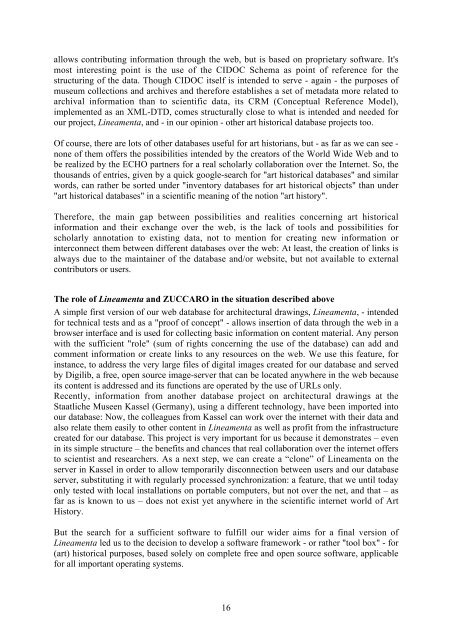European Cultural Heritage Online - ECHO
European Cultural Heritage Online - ECHO
European Cultural Heritage Online - ECHO
Create successful ePaper yourself
Turn your PDF publications into a flip-book with our unique Google optimized e-Paper software.
allows contributing information through the web, but is based on proprietary software. It'smost interesting point is the use of the CIDOC Schema as point of reference for thestructuring of the data. Though CIDOC itself is intended to serve - again - the purposes ofmuseum collections and archives and therefore establishes a set of metadata more related toarchival information than to scientific data, its CRM (Conceptual Reference Model),implemented as an XML-DTD, comes structurally close to what is intended and needed forour project, Lineamenta, and - in our opinion - other art historical database projects too.Of course, there are lots of other databases useful for art historians, but - as far as we can see -none of them offers the possibilities intended by the creators of the World Wide Web and tobe realized by the <strong>ECHO</strong> partners for a real scholarly collaboration over the Internet. So, thethousands of entries, given by a quick google-search for "art historical databases" and similarwords, can rather be sorted under "inventory databases for art historical objects" than under"art historical databases" in a scientific meaning of the notion "art history".Therefore, the main gap between possibilities and realities concerning art historicalinformation and their exchange over the web, is the lack of tools and possibilities forscholarly annotation to existing data, not to mention for creating new information orinterconnect them between different databases over the web: At least, the creation of links isalways due to the maintainer of the database and/or website, but not available to externalcontributors or users.The role of Lineamenta and ZUCCARO in the situation described aboveA simple first version of our web database for architectural drawings, Lineamenta, - intendedfor technical tests and as a "proof of concept" - allows insertion of data through the web in abrowser interface and is used for collecting basic information on content material. Any personwith the sufficient "role" (sum of rights concerning the use of the database) can add andcomment information or create links to any resources on the web. We use this feature, forinstance, to address the very large files of digital images created for our database and servedby Digilib, a free, open source image-server that can be located anywhere in the web becauseits content is addressed and its functions are operated by the use of URLs only.Recently, information from another database project on architectural drawings at theStaatliche Museen Kassel (Germany), using a different technology, have been imported intoour database: Now, the colleagues from Kassel can work over the internet with their data andalso relate them easily to other content in Lineamenta as well as profit from the infrastructurecreated for our database. This project is very important for us because it demonstrates – evenin its simple structure – the benefits and chances that real collaboration over the internet offersto scientist and researchers. As a next step, we can create a “clone” of Lineamenta on theserver in Kassel in order to allow temporarily disconnection between users and our databaseserver, substituting it with regularly processed synchronization: a feature, that we until todayonly tested with local installations on portable computers, but not over the net, and that – asfar as is known to us – does not exist yet anywhere in the scientific internet world of ArtHistory.But the search for a sufficient software to fulfill our wider aims for a final version ofLineamenta led us to the decision to develop a software framework - or rather "tool box" - for(art) historical purposes, based solely on complete free and open source software, applicablefor all important operating systems.16


